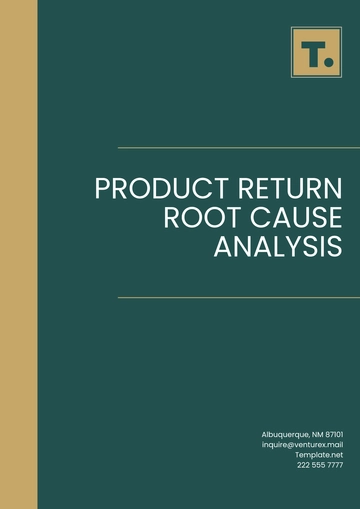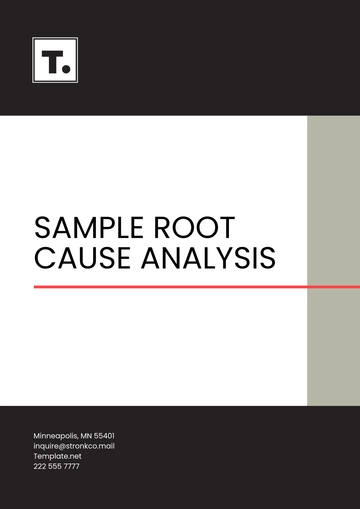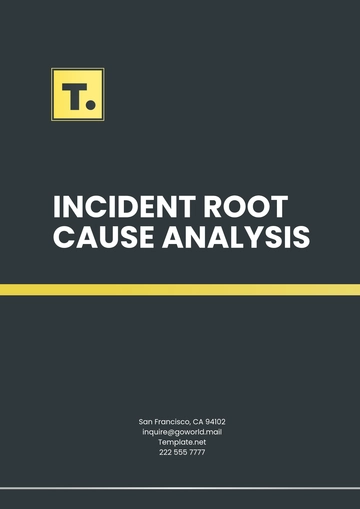Free Aesthetic Food Safety Root Cause Analysis

Prepared By: [YOUR NAME]
Date: January 1, 2060
I. Problem Description
The analysis aims to address a recurring aesthetic issue in our food production line. The primary concern involves the discoloration and textural inconsistencies in the fruit-based products. Initial observations indicated that freshly processed batches exhibit undesirable color variations and surface roughness, deviating from established quality standards. This issue has been noted in multiple batches since July 2060, impacting both the visual appeal and marketability of the products.
II. Root Cause Identification
1. Temperature Fluctuation
The investigation suggests that irregular temperature control during the storage and transportation phases could lead to enzymatic browning, resulting in color deterioration. It's crucial to maintain a consistently cool environment to inhibit unwanted chemical reactions.
2. Ingredient Contamination
There is potential cross-contamination from utensils or storage vessels previously used for high-acidity products. This synergistic effect may alter the product's pH balance, affecting its appearance and texture.
3. Inadequate Packaging
Improper sealing or material choice in packaging might allow moisture ingress, thereby affecting the product’s stability. This could lead to textural degradation over time when the moisture balance is disturbed.
III. Corrective Actions
1. Temperature Regulation
Set up temperature monitors with alerts for limit breaches.
Conduct regular maintenance on refrigeration units to ensure optimal performance.
2. Enhanced Cleaning Procedures
Introduce stringent sanitation protocols for equipment and storage facilities.
Cross-train staff to recognize risks of contamination and ensure compliance.
3. Packaging Improvements
Upgrade to moisture-resistant packaging materials.
Ensure seals are airtight and employ quality checks on a batch basis.
IV. Impact Assessment
The aesthetic issue notably compromises the perceived quality of products, potentially affecting consumer trust and sales. While not directly harmful, these issues can lead to a decline in consumer satisfaction, indirectly affecting public perception and brand reputation. Addressing these concerns promptly will sustain market position and prevent economic losses.
V. Verification and Monitoring Plan
Upon implementing corrective actions, the following verification strategies will be undertaken:
Regular audits of temperature logs and refrigeration unit performance records.
Routine microbial and chemical testing of products to rule out contamination leads.
Feedback loops involving quality assurance teams to assess packaging integrity.
Monthly review meetings to evaluate progress and adjust strategies will ensure ongoing compliance and efficacy.
VI. Responsible Parties
Department/Team | Roles |
|---|---|
Quality Assurance Team | Oversee the implementation of corrective actions and conduct regular inspections. |
Production Managers | Ensure daily operations comply with new protocols and address immediate issues. |
Maintenance Crew | Responsible for the regular service of refrigeration and packaging equipment. |
Hygiene Specialists | Develop and enforce enhanced cleaning and sanitation guidelines. |
Collaboration among these teams will be key to successful implementation and sustainability of quality improvements.
- 100% Customizable, free editor
- Access 1 Million+ Templates, photo’s & graphics
- Download or share as a template
- Click and replace photos, graphics, text, backgrounds
- Resize, crop, AI write & more
- Access advanced editor
Maintain impeccable food safety standards with the Aesthetic Food Safety Root Cause Analysis Template from Template.net. Perfect for identifying and resolving food safety concerns, this editable and customizable template combines functionality with aesthetic design. Editable in our AI Editor Tool, it can be tailored to suit various food industry requirements while ensuring compliance with safety protocols.





























